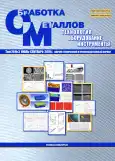Introduction. The performance characteristics of the surfaces of technical system parts are provided at the finishing operations of the manufacturing process by surface strengthening methods. Despite the fact that there are a sufficiently large number of surface strengthening methods, most of it have limited manufacturing application and require specific and expensive equipment for its implementation, others have not been put into practice on a large scale or have exhausted its technological potential. In this regard, the development of innovative methods of finishing and strengthening treatment of machine part surfaces is an issue of immediate relevance. The aim of the research is to increase the efficiency of strengthening based on the complex energy deposition in the surface layer of ferromagnetic parts by a rotating magnetic field and dynamic surface plastic deformation. The research hypothesis is as follows: the combined magnetic force has an effect on a ferromagnetic part surface, helps to refine the grains of the deformed metal to a nanoscale dimension and increases the depth of the modified (altered) surface layer. Methods and approaches. The paper presents a method of finishing and strengthening treatment, in which a concentrated energy flux of a rotating magnetic field and oscillating deforming balls, which perform multiple pulse-impact deformation, act simultaneously on the surface of a ferromagnetic part. In this case, the induction of the rotating magnetic field acting on the surface of the part is selected in the range from 0.10 to 1.20 T. In order to implement the method of finishing and strengthening treatment, a combined tool has been developed, which contains the following parts: a body; deforming balls freely installed in the annular chamber; magnetic system based on cylindrical permanent magnets made from rare-earth materials. The magnetic system of the tool is designed to create rotating magnetic field acting on the surface of the ferromagnetic part and transmit working oscillating motions to the deforming balls. The paper deals with characteristics of dislocation structures formed in the surface layer of steel and cast iron workpieces after strengthening by magnetic-dynamic rolling (MDR), combined treatment by MDR and a rotating constant magnetic field, combined treatment by MDR and a rotating alternating magnetic field. The research methods are as follows: X-ray diffraction studies of the surface layer; microstructural examination; X-ray microanalysis of the surface layer of strengthened workpieces made of steel and cast iron. Results and discussion. Analysis of the research findings allows establishing that a combined strengthening treatment by MDR and a rotating magnetic field makes it possible to form subgrain structure with nanoscale dimensions in the surface layer of steel and cast iron workpieces to a depth of up to 3.0 μm with a block size of up to 100 nm. In this case, there is an increase in the depth of the modified surface layer, in the dislocation density and in the lattice constant of the ferromagnetic materials being treated. Besides, compressive residual stresses in the strengthened surface layer of the samples are formed. It follows from the physical model of obtaining subgrain structure with nanoscale dimensions in the surface layer of ferromagnetic parts, which is presented in this paper, that the degree of grain crushing (grinding) of the material being strengthened is determined by the number of received force pulses from the deforming balls of the tool. The particles formed as a result of multiple crushing of grains and subgrains have an irregular asymmetric shape and a magnetic moment that does not coincide with the direction of the external magnetic field. As a consequence, the particles formed due to grain and subgrain crushing, trying to orient in the direction of the external magnetic field, turn in space and additionally smooth out the boundaries heated by local eddy currents in the area of their contact with the adjacent fragments of particles, characterized by accumulation of imperfections in the form of dislocations. The developed method of combined MDR belongs to nanotechnologies of surface modification and is recommended for implementation at machine building enterprises to improve operational properties of technical system parts.
 6-17
6-17


 18-35
18-35


 36-46
36-46


 47-57
47-57


 58-71
58-71


 72-84
72-84


 85-96
85-96


 97-108
97-108


 109-122
109-122


 123-133
123-133







